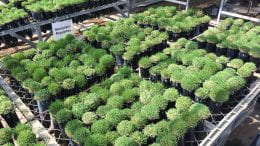Post provided by USGA By Cole Thompson, assistant director, Green Section Research

Genetics ultimately determine how well grasses tolerate the stresses of golf as well as the most suitable playing surfaces and geographic regions for use. At times, management strategies may compensate for genetic shortcomings. For example, many cool-season grasses have excellent quality at very low cutting heights but require frequent irrigation and pesticide applications to mitigate damage from heat, drought or pests. Alternatively, some warm-season grasses tolerate drought and potential pests better than cool-season grasses, but may not provide the desired aesthetics or have the cold tolerance necessary to excel in colder regions. These compromises can make turfgrass selection challenging, especially in regions with diverse environmental conditions.
Because reliable turfgrass performance and resource efficiency are becoming more important to golf facilities, many are opting to use warm-season grasses and risking potential injury during harsh winters. In the case of ultradwarf bermudagrass putting greens, covering during low temperatures accounts for insufficient cold tolerance in the transition-zone region of the U.S.A. This is effective, but another strategy is to improve the genetics of warm-season grasses to diminish tradeoffs and reduce the resources required to deliver high-quality turf in a challenging environment.
Zoysiagrass is a warm-season grass that has already helped golf courses in the transition zone to use resources more efficiently. There are several species of zoysiagrass with different morphologies and cold tolerances. In general, zoysiagrass cultivars provide a high-quality playing surface with lower water, fertilizer and pesticide requirements than cool-season – and even some warm-season – grasses. The cold tolerance of Zoysia japonica cultivars – e.g., ‘Meyer’ – has made them ideal for fairways in the transition zone. To improve quality and further improve cold, shade and pest tolerances, the USGA has supported zoysiagrass development at Texas A&M University since 1983. The cultivars ‘Diamond’, ‘Cavalier’, ‘Crowne’ and ‘Palisades’ were developed and released from this support.
Since 2004, scientists at Texas A&M have partnered with colleagues at Kansas State University and Purdue University (since 2012). Initial success has come from crossing Zoysia japonica types with Zoysia matrella types, which have finer and denser leaves but less cold tolerance. ‘Innovation’ is a new cultivar released from these efforts, which has better quality and similar cold tolerance than ‘Meyer’ – the current standard-bearer for zoysiagrass in the transition zone. Since 2012, this group of scientists has worked to incorporate large patch disease resistance into their higher-quality, cold-tolerant zoysiagrass hybrids. They developed more than 2,800 new zoysiagrass hybrids and evaluated them in Dallas, Texas; Manhattan, Kansas; and West Lafayette, Indiana, from 2012 through 2014. The hunting billbug emerged as a problematic pest during this cycle of evaluation and hunting billbug resistance has since been a trait of interest. Researchers then selected the best 60 hybrid lines and evaluated them in 10 transition-zone locations from 2015 to 2018.
The 10 best hybrid lines have been advanced from the most recent evaluations for further testing. Large patch and hunting billbug resistance are improved in these lines when compared to ‘Meyer’, and some have better cold tolerance than ‘Meyer’. In 2018, the researchers began crossing these hybrid lines with lesser used zoysiagrass species such as Zoysia pacifica, Zoysia minima and Zoysia pauciflora, which have an even finer texture than Zoysia matrella types. Their ultimate goal is to produce zoysiagrass cultivars with all the aforementioned traits for fairways, tees and even putting greens.
